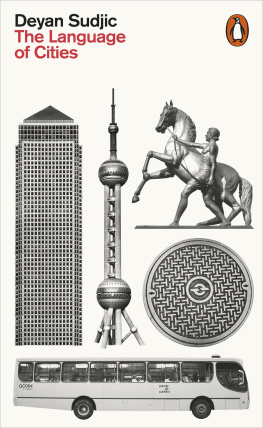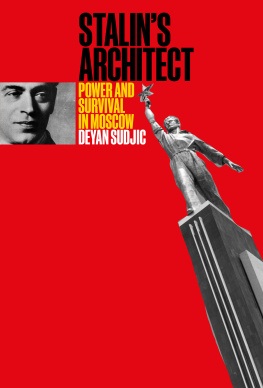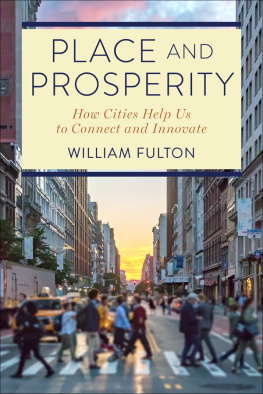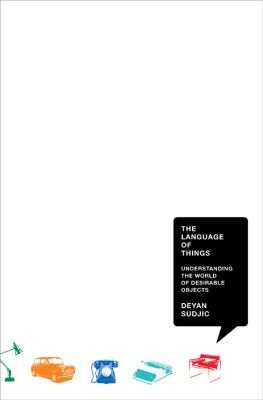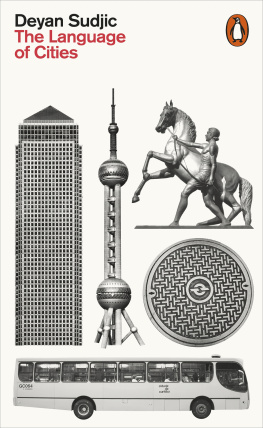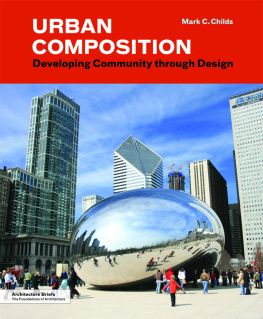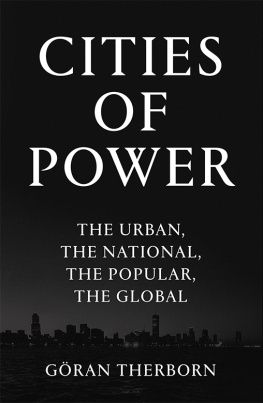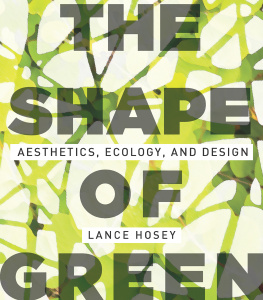Deyan Sudjic is Director of the Design Museum. He was born in London, and studied architecture in Edinburgh. He has worked as a critic for the Observer and the Sunday Times, as the editor of Domus in Milan, as the director of the Venice Architecture Biennale, and as a curator in Glasgow, Istanbul and Copenhagen. He is the author of B is for Bauhaus, The Language of Things and The Edifice Complex.
Acknowledgements
Much of this book was written in a farmhouse half an hour from Sienas Palazzo Pubblico. It was a chance to spend more time with Ambrogio Lorenzettis famous mural, The Allegory of Good and Bad Government. For six centuries it has been both an inspiration and a caution, and not just to Sienas leaders. It is a reminder of how long we have tried to find ways to understand the nature of the city, simultaneously as a work of art, a moral and technical system and a reflection of how we live together.
Writing the book over the course of two summers was a comparatively quick process. Helen Conford, my clear-sighted editor at Penguin, helped shape the book into a set of questions about the nature of cities, and the book has further benefitted from the imaginative picture research of Cecilia Mackay and the careful copy-editing of Sarah Coward.
Questions about the nature of cities have fascinated me for many years. Looking at cities, how they change, and why they dont change, has fascinated me ever since I was growing up in the London of the 1950s and 60s, a city that from the prospect of 2016 seems both unimaginably different and eerily familiar.
It is twenty-five years since I wrote The 100 Mile City. That book began life as a commission to explore the impact of gentrification, but quickly morphed into an attempt to get to grips with the much more far-reaching set of changes that had reshaped so many cities, and made them part of a global system. As a journalist at the Observer and as editor of Domus, I was able to travel to see cities from Tokyo to Beijing, Jakarta to Melbourne, Johannesburg, Singapore, Seoul and Moscow.
It was The 100 Mile City that persuaded Ricky Burdett, director of the Cities Programme at the London School of Economics, to invite me to take part in The Urban Age, the series of conferences and studies undertaken over the course of a decade with the Alfred Herrhausen Society of Deutsche Bank. The Urban Age was a uniquely privileged insight into the intricate and sometimes fraught connections between law, transport policy, development, politics and leadership, architecture and planning, sociology and ecology. The Urban Age was a powerful argument for understanding the city as the product of all these issues, conventionally never considered as part of a coherent whole.
The Urban Age gave me the chance to begin work on some of the ideas that are crystallized here, and most importantly to learn from many thinkers in all those disciplines. In particular, I had the chance to learn from Richard Sennett and Saskia Sassen, Philipp Rode, Enrique Penalosa, Suketa Mehta, Jose Castillo Olea, Gerald Frug, Tony Travers, and many others.
I also had the opportunity to contribute to a record of those conferences in two substantial publications: The Endless City, and Living in the Endless City.
Without that experience and those dialogues, this would have been a very different book.
The experience has taught me that it is not enough only to observe, and report back. This is a book that tries to answer some questions about what makes a city, as well as to ask them.
Bibliography
Alexander, Christopher, A City is Not a Tree. 1965, reprinted 2015, Sustasis Press.
Alexander, Christopher, A Pattern Language. OUP, 1978.
Banham, Reyner, Los Angeles: The Architecture of Four Ecologies. Allen Lane, London, 1971.
Brook, Daniel, A History of Future Cities. Norton, New York, 2013.
Burdett, Richard and Sudjic, Deyan, The Endless City. Phaidon, London, 2008.
Burdett, Richard and Sudjic, Deyan (eds.), Living in the Endless City. Phaidon, London, 2011.
Caro, Robert, The Power Broker: Robert Moses and the Fall of New York. Knopf, New York, 1974.
Dickens, Charles, Dombey and Son. Penguin Books, London, 2002.
Ehrenhalt, Alan, The Great Inversion. Vintage, New York, 2013.
Engels, Friedrich, The Condition of the Working Class in England, Oxford World Classics Edition, 2009.
Gans, Herbert, People and Plans. Columbia University Press, New York, 1964.
Hall, Peter, Great Planning Disasters, revised edition. Penguin Books, London, 1981.
Jacobs, Jane, The Death and Life of Great American Cities. Random House, New York, 1961.
Jacobs, Jane, The Economy of Cities. Random House, New York, 1969.
Kirkland, Stephane, Paris Reborn: Napoleon III, Baron Haussmann and the Quest to Build a Modern City. St Martins Press, New York, 2013.
Koolhaas, Rem, Delirious New York. Oxford University Press, 1978, new edition, Monacelli, New York, 1994.
McGuirk, Justin, Radical Cities. Verso, London, 2014.
Morris, William, News From Nowhere. Penguin Books, 1993.
Pamuk, Orhan, The Museum of Innocence, translated by Maureen Freely. Faber, London, 2010.
Rossi, Aldo, The Architecture of the City. English translation MIT, Cambridge, 1984.
Rubinstein, Nicolai, Political Ideas in Sienese Art: The Frescoes by Ambrogio Lorenzetti and Tadeo di Bartolo in the Palazzo Publico, Journal of the Warburg and Courtauld Institutes. London JulyDec 1958.
Schickel, Richard, The Disney Version, revised edition. Pavilion, London 1986.
Sitte, Camillo, Cities Built According to Artistic Principles, 1889, translated 1945.
Sudjic, Deyan, The Edifice Complex. Allen Lane, London, 2006.
Sudjic, Deyan and Deutsch, Andre The 100 Mile City, London, 1992.
Venturi, Robert, Scott Brown, Denise and Izenour, Steven, Learning from Las Vegas, revised edition. Cambridge, MIT, 1977.
Whiteley, Nigel, Reyner Banham: Historian of the Immediate Future. MIT, 2002.
Zola, mile, Au Bonheur des Dames, translated by Robin Buss. Penguin Books, London, 2001.
CHAPTER ONE
What is a City
City is a word used to describe almost anything. A tiny settlement in the mid-West, with fewer than 10,000 people, and nothing more than a sheriff to represent civic authority, is called a city. So is Tokyo, with a population approaching 40 million, an urban structure based on multiple electoral districts, a parliamentary chamber, a governor, a prefectural government employing 250,000 people and a multi-billion dollar budget.
If anywhere can be defined as a city, then the definition runs the risk of meaning nothing. A city is made by its people, within the bounds of the possibilities that it can offer them: it has a distinctive identity that makes it much more than an agglomeration of buildings. Climate, topography and architecture are part of what creates that distinctiveness, as are its origins. Cities based on trade have qualities different from those that were called into being by manufacturing. Some cities are built by autocrats, others have been shaped by religion. Some cities have their origins in military strategy or statecraft.
Next page
